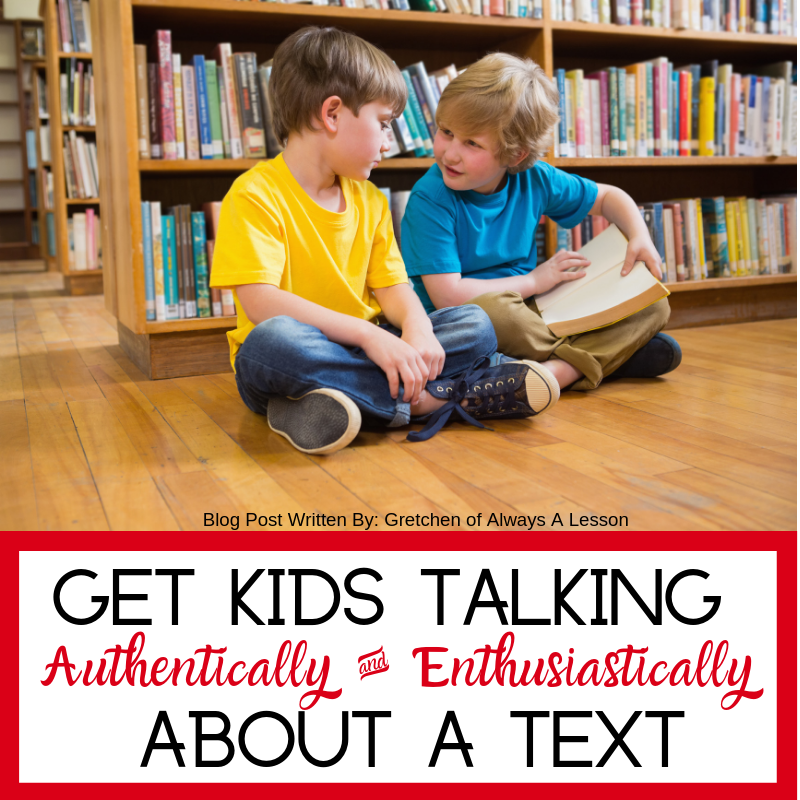Text Talk: Get Kids Talking Authentically & Enthusiastically About a Text
One challenge teachers face is the lack of quality text talk in the classroom. This means teachers are struggling to get students excited to engage in meaningful conversations with each other about the books that they are reading. It is important for students to develop text based discussion skills because it increases reading comprehension while strengthening peer relationships. Although it is a common challenge for teachers to get students to love reading and engaging in text talks, it does not need to remain an obstacle in the student learning process any longer.
There are three reasons text talk remains invisible and ineffective in classrooms today. If we do it well and do it often, students will begin to talk authentically and enthusiastically about a text. Follow the suggestions mentioned below to overcome the three common challenges related to text talks in your own classroom:
The teacher has not modeled their own excitement for reading to the students.
Part of the reason students do not engage in conversations with their peers about the books that they are reading is because they do not enjoy the process of reading. When they do not enjoy the process of reading, it leaves behind little interest to talk about what they are reading with peers.
Whether it’s peer pressure or cultural norms, the enjoyment of reading can be looked upon poorly by children. For example, if sports is a more popular hobby than reading, any student who loves to read is going to be singled out negatively. This reaction can easily be avoided. When the teacher establishes an environment in which reading is accessible and celebrated, students will begin to feel safe enough to explore the world of reading. Once the new established norm of reading is developed, it opens up the possibility for students to fall in love with it.
One way to build excitement for reading is to model it in everyday life. The teacher can read books of their own choice in front of students so that they realize that reading isn’t just a school assignment, but an enjoyable activity. Then, the teacher can celebrate students own love for reading by allowing them to share their excitement about what they are reading in front of their peers. By setting the tone for reading excitement in the classroom, teachers can combat student disinterest in engaging with their peers about books.
The teacher has not provided a structured example for how to engage in text talk conversations.
In order for students to engage in text talks successfully, they need to understand the structure of such a conversation. The teacher can provide a model text talk where students can witness a back-and-forth conversation between two people about a common text. The teacher can then provide a structured guide for the flow of discussion to help students get comfortable talking about books. This will ease anxiety and increase momentum of the conversation. This might look like providing sentence stems on aspects of the storyline to spark conversation. For example:
- Characters: What is the goal of the main character and how do you know?
- Setting: Why do you think this setting is important to the storyline?
- Plot: Sequence story events in chronological order.
When the teacher provides a road map to success, students can be encouraged to take risks because the bar for failure is low. “I don’t know how” is no longer an acceptable response. As students gain familiarity in the format, the structured support from the teacher can dwindle to allow for student creativity and authenticity to spike.
The students have little practice in text talk (text- based discussions) themselves due to lack of time or opportunity.
Once students understand what an ideal text talk looks and sounds like, a teacher must give them time to practice. By following the gradual release of responsibility approach, teachers can first model a text talk followed by leading students and their peers through a scaffolded text talk, and then end with students independently engaging in a text talk.
The best way to get started is to find a common text students would be interested in and/or covers a curricular topic of focus. Then, provide time for students to read a specified section of the text (ie. chapter one) before coming together to talk. Lastly, allow students multiple opportunities to talk about a text. This might mean that the teacher incorporates this discussion strategy into multiple subject areas throughout the day so students get used to the procedure of a text talk while learning how to talk about a variety of topics.
If students still struggle to enjoy the peer discussion activity, try to spice it up with a game. Give a literacy discussion dice activity a try- versions available for fiction, non-fiction, biography, and poetry texts. (Or you can grab all of the dice game genre activities here.)
Students will learn to have authentic, engaging peer discussions about a common text if you provide a safe place to learn to love reading, model a successful text talk, and provide multiple opportunities to practice it.
How do you incorporate opportunities for students to engage in meaningful conversations about a text in your classroom?


